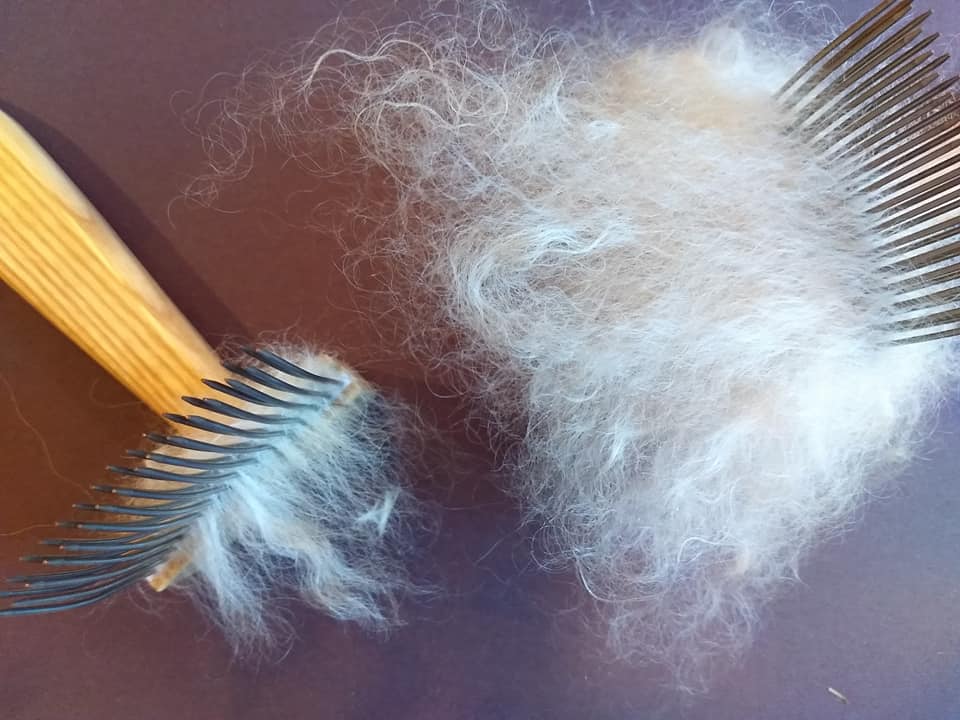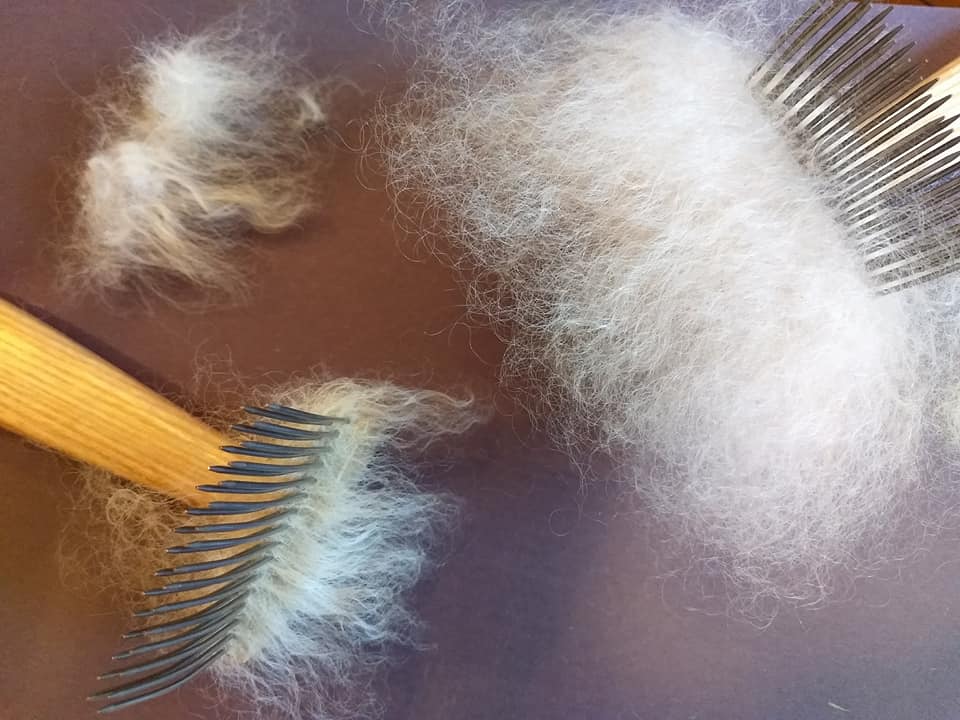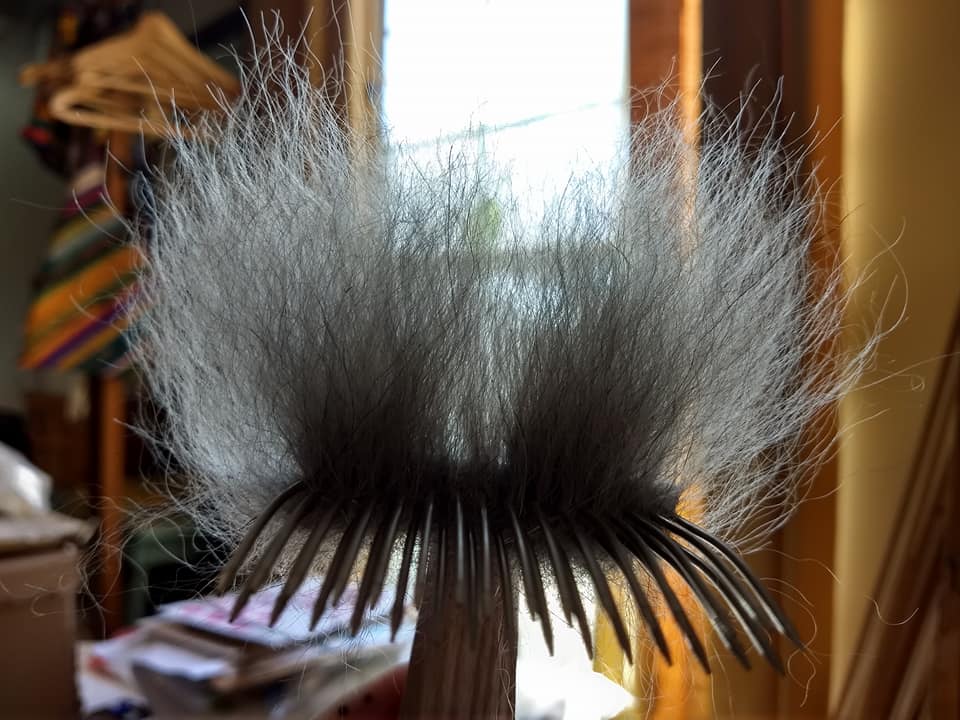All Pygora fiber needs to be dehaired, Not everyone has the time or desire to dehair their own fleeces and opt to send their fleeces to a mill for processing. However, dehairing Pygora Fiber by hand is something EVERY Pygora owner and especially every Pygora breeder should know how to do. Not just so that you can process your own fiber, but so that you can test your fleeces and see what type of separation that you are getting in your herd. Hope this is helpful for those of you interested in deharing fleeces on your own. Below, you will find examples of deharing A, B & C type fleeces, and a few tips for storing your combs, and organizing your herd samples.
Dehairing some of Little Hawk Farm Dolly's fleece using Louet Mini Combs. Dehairing is the process of separating the guard hairs from the fine fibers. I am working with a raw type B Pygora fleece off of LHF Dolly. Her fleece is super fine and has great ease of separation. Her fleece was tested and qualified her to be dual registered as both Pygora and Cashmere.
Another option for deharing is using a hand carder. Not all fleeces can be dehaired this way, but for some it works really well.
Dehairing LHF Dolly's Pygora fleece using a hand carder. This fleece has amazing separation. Typically I use hand combs to dehair a fleece, but this fleece works really well to use a hand carder. Dehairing a fleeces is the process in which you separate the guard hair from the fine fibers. If the guard hairs are left in the fleece they will cause the finished yarn to be prickly. By separating them out of Dolly's fleece we are left with the fine cashmere fibers to work with.
Dehairing LHF Dolly's Pygora fleece using a hand carder. This fleece has amazing separation. Typically I use hand combs to dehair a fleece, but this fleece works really well to use a hand carder. Dehairing a fleeces is the process in which you separate the guard hair from the fine fibers. If the guard hairs are left in the fleece they will cause the finished yarn to be prickly. By separating them out of Dolly's fleece we are left with the fine cashmere fibers to work with.
Here is a good example of dehairing a type B fleece.
Type B - this fleece is a strong, lustrous fiber that is curly and very soft and fine, testing below 24 microns on average. A type-B fleece averages 3-6 inches long, and may have two types of guard hairs: an obvious, stiff guard hair and a silky guard hair. It is the uniquely Pygora fleece - very versatile, warm to the touch and soft. Type-B goats usually are shorn twice a year. The fleece color usually is lighter than the guard hair color. (PBA website)
Type B - this fleece is a strong, lustrous fiber that is curly and very soft and fine, testing below 24 microns on average. A type-B fleece averages 3-6 inches long, and may have two types of guard hairs: an obvious, stiff guard hair and a silky guard hair. It is the uniquely Pygora fleece - very versatile, warm to the touch and soft. Type-B goats usually are shorn twice a year. The fleece color usually is lighter than the guard hair color. (PBA website)
Deharing a type A Pygora fleece isn't so different than a type B, but you are looking for a slight difference in the guard hairs, that you will be finding.
Type A - this fleece averages 6 inches in length, is long, lustrous, has ringlets and should have very few guard hairs. The fiber is very fine, usually less than 28 microns, and feels silky, smooth and cool to the touch. Type-A goats usually are shorn twice a year. (PBA website)
Type A - this fleece averages 6 inches in length, is long, lustrous, has ringlets and should have very few guard hairs. The fiber is very fine, usually less than 28 microns, and feels silky, smooth and cool to the touch. Type-A goats usually are shorn twice a year. (PBA website)
I didn't have any type C goats when I did the tutorial... but, I found a sample that had been sent to me years ago. I was pretty happy with how it separated and dehaired with the mini combs. The guard hairs were defined and separated out easily, leaving a soft fine undercoat. Some of the fine under coat was taken out in the first couple passes, due to some vm.
Type C this fleece is a matte fiber with crimp and a very short staple length (usually 1-3 inches). It has a very obvious, coarse guard hair and is warm to the touch. Type C is the finest of the three fleece types, usually below 18.5 microns, and can be as soft as fine cashmere. There is good separation between the guard hair and fleece. A type-C coat can be harvested by brushing, plucking or shearing. The yield is small, but the effort is worth it. Type-C fleece is unbelievably soft. The fleece color is usually lighter than the guard hair color. (from the PBA website)
Type C this fleece is a matte fiber with crimp and a very short staple length (usually 1-3 inches). It has a very obvious, coarse guard hair and is warm to the touch. Type C is the finest of the three fleece types, usually below 18.5 microns, and can be as soft as fine cashmere. There is good separation between the guard hair and fleece. A type-C coat can be harvested by brushing, plucking or shearing. The yield is small, but the effort is worth it. Type-C fleece is unbelievably soft. The fleece color is usually lighter than the guard hair color. (from the PBA website)





















